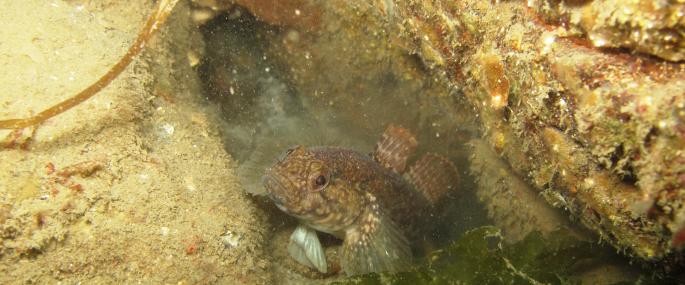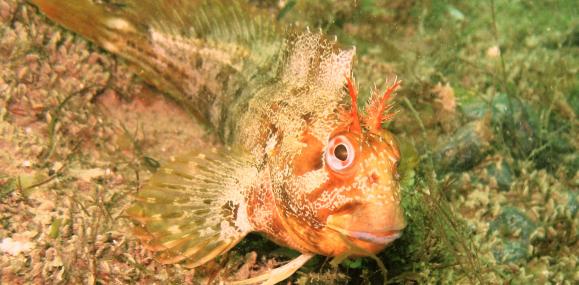Sunfish
A bizarre fish, silvery grey in colour, flat and circular, with no noticeable tail and two very large fins, one on each side, which make it look like a giant swimming head! The Sunfish is the heaviest bony fish in the sea and sometimes turns up in British waters after storms out at sea. May also be seen from ferries, 'basking' at the surface of the water on its side. Its mouth is adapted into a beak which is uses to feed on jellyfish.
Although not commercially important, Sunfish are a product of bycatch and as a result are under threat from fishing activities. The Wildlife Trusts are working with fishermen, researchers, politicians and local people towards a vision of 'Living Seas', where marine wildlife thrives. This work has recently had a massive boost with the passing of the Marine Bill, promising sustainable development of the UK's marine environment. Do your bit for our Living Seas by supporting your local Wildlife Trust.
Plaice
The Plaice is a diamond-shaped flatfish which lives on the sea bottom, on sandy or gravel shores. Young fish can sometimes be found in rockpools. Plaice are mainly nocturnal, feeding on molluscs and worms which they crush with their strong jaws. During the day, they tend to bury themselves in sand or gravel, lying hidden and well-camouflaged.
Plaice are a commercially important species and are under threat from overfishing. You can help by being careful about what you choose in the supermarket - go for sustainably produced fish and shellfish, preferably with the Marine Stewardship Council's logo. The Wildlife Trusts are working with fishermen, researchers, politicians and local people towards a vision of 'Living Seas', where marine wildlife thrives.

Lumpsucker
The Lumpsucker is a large, lumpy fish which lives amongst seaweed and rocks around or below the low tide mark. Their pectoral fins form a suction ring that enables them to 'stick' to rocks around the surf zone, preventing it from being washed away by the waves.
Lumpsuckers and other small fish provide a vital link in the food chain for many of our rarer species. Our seas and coastline are in need of protection if we are to keep our marine wildlife healthy. The Wildlife Trusts are working with fishermen, researchers, politicians and local people towards a vision of 'Living Seas', where marine wildlife thrives. This work has recently had a massive boost with the passing of the Marine Bill, promising sustainable development of the UK's marine environment. Do your bit for our Living Seas by supporting your local Wildlife Trust.
Rock Goby
The Rock Goby is a small, elongated, large-headed fish found in rockpools and shallow, rocky seas and is present in waters up to 15 metres deep. On its underside, the pectoral fins are fused to form a sucker which it uses to attach itself to rocks to prevent it being washed away by the waves.
Our seas and coastline are in need of protection if we are to keep our marine wildlife healthy. The Wildlife Trusts are working with fishermen, researchers, politicians and local people towards a vision of 'Living Seas', where marine wildlife thrives. This work has recently had a massive boost with the passing of the Marine Bill, promising sustainable development of the UK's marine environment. Do your bit for our Living Seas by supporting your local Wildlife Trust.

Tompot Blenny
The Tompot Blenny is a medium-sized, elongated, large-headed, large-eyed fish found in crevices amongst rocks below the low tide line. It has two branched, feathery tentacles on the top of the head, one above each eye. The Tompot is a very inquisitive fish, often approaching scuba divers to have a closer look.
Our seas and coastline are in need of protection if we are to keep our marine wildlife healthy. The Wildlife Trusts are working with fishermen, researchers, politicians and local people towards a vision of 'Living Seas', where marine wildlife thrives. This work has recently had a massive boost with the passing of the Marine Bill, promising sustainable development of the UK's marine environment. Do your bit for our Living Seas by supporting your local Wildlife Trust.

Shanny
The Shanny is a small, elongated, large-headed, large-eyed fish found in rockpools and shallow, rocky seas. It can often be spotted hiding under stones and seaweed, emerging at high tide to forage over the shore. It can also be found around man-made structures such as pier pilings.
Our seas and coastline are in need of protection if we are to keep our marine wildlife healthy. The Wildlife Trusts are working with fishermen, researchers, politicians and local people towards a vision of 'Living Seas', where marine wildlife thrives. This work has recently had a massive boost with the passing of the Marine Bill, promising sustainable development of the UK's marine environment. Do your bit for our Living Seas by supporting your local Wildlife Trust.

Butterfish
A long, eel-like fish found in seaweeds, crevices and under rocks in rockpools and shallow, rocky seas. Both the males and females of this species take turns to guard their unhatched eggs.
Our seas and coastline are in need of protection if we are to keep our marine wildlife healthy. The Wildlife Trusts are working with fishermen, researchers, politicians and local people towards a vision of 'Living Seas', where marine wildlife thrives. This work has recently had a massive boost with the passing of the Marine Bill, promising sustainable development of the UK's marine environment. Do your bit for our Living Seas by supporting your local Wildlife Trust.

Lesser Spotted Dogfish
The Lesser Spotted Dogfish is a small shark, so named due to the dark spots and blotches covering its skin. All sharks have very rough skin, covered in hard 'dermal denticles' literally meaning 'tiny skin teeth'. If rubbed the wrong the way, they are very coarse like sandpaper, but provide the shark with an effective chainmail-like protective covering. Dogfish are predators, feeding on shellfish and other small fish.
Our seas and coastline are in need of protection if we are to keep our marine wildlife healthy. The Wildlife Trusts are working with fishermen, researchers, politicians and local people towards a vision of 'Living Seas', where marine wildlife thrives. This work has recently had a massive boost with the passing of the Marine Bill, promising sustainable development of the UK's marine environment. Do your bit for our Living Seas by supporting your local Wildlife Trust.

Basking Shark
The Basking Shark is the second largest fish in our oceans - its relative the Whale Shark being the biggest. Despite their size, Basking Sharks actually feed on plankton which they filter out of the water, swimming slowly back and forth with their enormous mouths wide open. They are most commonly seen in the summer, when they gather in British waters. Try looking from cliffs or boats offshore in the south and west.
Basking Sharks are seriously threatened by overfishing - they were traditionally caught for their vast livers, but are now a target of the shark fin soup trade. It's thought that Basking Shark populations have decreased by 80 % since the 1950s. The Wildlife Trusts are working with fishermen, researchers, politicians and local people towards a vision of 'Living Seas', where marine wildlife thrives. This work has recently had a massive boost with the passing of the Marine Bill, promising sustainable development of the UK's marine environment. Do your bit for our Living Seas by supporting your local Wildlife Trust.

Sea Potato
Also known as the 'Heart Urchin' due to its distinctive shape, this medium-sized sea-urchin is densely covered in fine, beige spines, giving it a hairy appearance. The Sea Potato lives buried in up to 15cm of muddy and sandy sediments from the shore to 200 metres deep.
Sea-urchins and starfish provide a vital link in the food chain for many of our rarer species. Our seas and coastline are in need of protection if we are to keep our marine wildlife healthy. The Wildlife Trusts are working with fishermen, researchers, politicians and local people towards a vision of 'Living Seas', where marine wildlife thrives. This work has recently had a massive boost with the passing of the Marine Bill, promising sustainable development of the UK's marine environment. Do your bit for our Living Seas by supporting your local Wildlife Trust.
